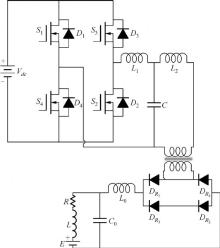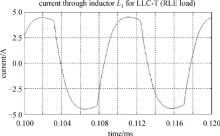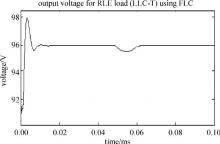
|
|
Fig.1 Series parallel resonant converter
|

|
|
Fig.1 Series parallel resonant converter
|

|
|
Fig.1 Series parallel resonant converter
|

|
|
Fig.1 Series parallel resonant converter
|

|
|
Fig.1 Series parallel resonant converter
|

|
|
Fig.2 Equivalent circuit model of LCL-T SPRC
|

|
|
Fig.2 Equivalent circuit model of LCL-T SPRC
|

|
|
Fig.2 Equivalent circuit model of LCL-T SPRC
|

|
|
Fig.2 Equivalent circuit model of LCL-T SPRC
|

|
|
Fig.2 Equivalent circuit model of LCL-T SPRC
|

|
|
Fig.3 Equivalent circuit model for LLC-T SPRC
|

|
|
Fig.3 Equivalent circuit model for LLC-T SPRC
|

|
|
Fig.3 Equivalent circuit model for LLC-T SPRC
|

|
|
Fig.3 Equivalent circuit model for LLC-T SPRC
|

|
|
Fig.3 Equivalent circuit model for LLC-T SPRC
|

| change in error (ce) | error (e) |
|---|
| NH | N | NS | Z | PL | P | PH |
|---|
| NB | NH | NH | NH | NH | N | NL | Z | | N | NH | NH | N | N | NL | Z | PL | | NL | NH | N | NL | NL | Z | PL | P | | Z | NH | N | NL | Z | PL | P | PH | | PL | N | NL | Z | PL | PL | P | PH | | P | NL | Z | PL | P | P | PH | PH | | PH | Z | PL | P | PH | PH | PH | PH |
|
|
Tab.1 Fuzzy rules
|

|
|
Fig.4 Resonant current and resonant voltage for = 100 V
|

|
|
Fig.4 Resonant current and resonant voltage for = 100 V
|

|
|
Fig.4 Resonant current and resonant voltage for = 100 V
|

|
|
Fig.4 Resonant current and resonant voltage for = 100 V
|

|
|
Fig.4 Resonant current and resonant voltage for = 100 V
|

|
|
Fig.5 Voltages across parallel capacitor ()
|

|
|
Fig.5 Voltages across parallel capacitor ()
|

|
|
Fig.5 Voltages across parallel capacitor ()
|

|
|
Fig.5 Voltages across parallel capacitor ()
|

|
|
Fig.5 Voltages across parallel capacitor ()
|

|
|
Fig.6 Current through inductance (LLC-T SPRC with FLC fed RLE load)
|

|
|
Fig.6 Current through inductance (LLC-T SPRC with FLC fed RLE load)
|

|
|
Fig.6 Current through inductance (LLC-T SPRC with FLC fed RLE load)
|

|
|
Fig.6 Current through inductance (LLC-T SPRC with FLC fed RLE load)
|

|
|
Fig.6 Current through inductance (LLC-T SPRC with FLC fed RLE load)
|

|
|
Fig.7 Output voltage for step change in supply at = 0.05 ms
|

|
|
Fig.7 Output voltage for step change in supply at = 0.05 ms
|

|
|
Fig.7 Output voltage for step change in supply at = 0.05 ms
|

|
|
Fig.7 Output voltage for step change in supply at = 0.05 ms
|

|
|
Fig.7 Output voltage for step change in supply at = 0.05 ms
|

|
|
Fig.8 Output voltage for step change in load at = 0.05 ms
|

|
|
Fig.8 Output voltage for step change in load at = 0.05 ms
|

|
|
Fig.8 Output voltage for step change in load at = 0.05 ms
|

|
|
Fig.8 Output voltage for step change in load at = 0.05 ms
|

|
|
Fig.8 Output voltage for step change in load at = 0.05 ms
|

|
|
Fig.9 Resonant current and resonant voltage for = 100 V (LCL-T SPRC with FLC fed RLE load)
|

|
|
Fig.9 Resonant current and resonant voltage for = 100 V (LCL-T SPRC with FLC fed RLE load)
|

|
|
Fig.9 Resonant current and resonant voltage for = 100 V (LCL-T SPRC with FLC fed RLE load)
|

|
|
Fig.9 Resonant current and resonant voltage for = 100 V (LCL-T SPRC with FLC fed RLE load)
|

|
|
Fig.9 Resonant current and resonant voltage for = 100 V (LCL-T SPRC with FLC fed RLE load)
|

|
|
Fig.10 Voltages across parallel capacitor () (LCL-T SPRC with FLC fed RLE load)
|

|
|
Fig.10 Voltages across parallel capacitor () (LCL-T SPRC with FLC fed RLE load)
|

|
|
Fig.10 Voltages across parallel capacitor () (LCL-T SPRC with FLC fed RLE load)
|

|
|
Fig.10 Voltages across parallel capacitor () (LCL-T SPRC with FLC fed RLE load)
|

|
|
Fig.10 Voltages across parallel capacitor () (LCL-T SPRC with FLC fed RLE load)
|

|
|
Fig.11 Current through inductance (LCL-T SPRC with FLC fed RLE load)
|

|
|
Fig.11 Current through inductance (LCL-T SPRC with FLC fed RLE load)
|

|
|
Fig.11 Current through inductance (LCL-T SPRC with FLC fed RLE load)
|

|
|
Fig.11 Current through inductance (LCL-T SPRC with FLC fed RLE load)
|

|
|
Fig.11 Current through inductance (LCL-T SPRC with FLC fed RLE load)
|

|
|
Fig.12 Output voltage for step change in supply at = 0.05 ms
|

|
|
Fig.12 Output voltage for step change in supply at = 0.05 ms
|

|
|
Fig.12 Output voltage for step change in supply at = 0.05 ms
|

|
|
Fig.12 Output voltage for step change in supply at = 0.05 ms
|

|
|
Fig.12 Output voltage for step change in supply at = 0.05 ms
|

|
|
Fig.13 Output voltage for step change in load at = 0.05 ms
|

|
|
Fig.13 Output voltage for step change in load at = 0.05 ms
|

|
|
Fig.13 Output voltage for step change in load at = 0.05 ms
|

|
|
Fig.13 Output voltage for step change in load at = 0.05 ms
|

|
|
Fig.13 Output voltage for step change in load at = 0.05 ms
|

| resonant topologies | settling time/ms | overshoot% | steady-state error/V |
|---|
| LCL-T | 0.01 | 1 | 0.001 | | LLC-T | 0.025 | 3 | 0.004 |
|
|
Tab.2 Comparative evaluation of transient and steady-state performances by using FLC
|

|
|
Fig.14 Frequency response of LLC-T SPRC
|

|
|
Fig.14 Frequency response of LLC-T SPRC
|

|
|
Fig.14 Frequency response of LLC-T SPRC
|

|
|
Fig.14 Frequency response of LLC-T SPRC
|

|
|
Fig.14 Frequency response of LLC-T SPRC
|

|
|
Fig.15 Frequency response of LCL-T SPRC
|

|
|
Fig.15 Frequency response of LCL-T SPRC
|

|
|
Fig.15 Frequency response of LCL-T SPRC
|

|
|
Fig.15 Frequency response of LCL-T SPRC
|

|
|
Fig.15 Frequency response of LCL-T SPRC
|

|
|
Fig.16 CH1: resonant voltage [volt scale: 40 V/div], CH2: resonant current [ampere scale: 0.5 A/div] for LLC-T SPRC
|

|
|
Fig.16 CH1: resonant voltage [volt scale: 40 V/div], CH2: resonant current [ampere scale: 0.5 A/div] for LLC-T SPRC
|

|
|
Fig.16 CH1: resonant voltage [volt scale: 40 V/div], CH2: resonant current [ampere scale: 0.5 A/div] for LLC-T SPRC
|

|
|
Fig.16 CH1: resonant voltage [volt scale: 40 V/div], CH2: resonant current [ampere scale: 0.5 A/div] for LLC-T SPRC
|

|
|
Fig.16 CH1: resonant voltage [volt scale: 40 V/div], CH2: resonant current [ampere scale: 0.5 A/div] for LLC-T SPRC
|

|
|
Fig.17 Output voltage for LLC-T SPRC with load and supply disturbance at = 0.05 ms (CH1: volt scale: 50 V/div)
|

|
|
Fig.17 Output voltage for LLC-T SPRC with load and supply disturbance at = 0.05 ms (CH1: volt scale: 50 V/div)
|

|
|
Fig.17 Output voltage for LLC-T SPRC with load and supply disturbance at = 0.05 ms (CH1: volt scale: 50 V/div)
|

|
|
Fig.17 Output voltage for LLC-T SPRC with load and supply disturbance at = 0.05 ms (CH1: volt scale: 50 V/div)
|

|
|
Fig.17 Output voltage for LLC-T SPRC with load and supply disturbance at = 0.05 ms (CH1: volt scale: 50 V/div)
|

|
|
Fig.18 CH1: resonant voltage [volt scale: 40 V/div]. CH2: resonant current [ampere scale: 0.5 A/div] for LCL-T SPRC.
|

|
|
Fig.18 CH1: resonant voltage [volt scale: 40 V/div]. CH2: resonant current [ampere scale: 0.5 A/div] for LCL-T SPRC.
|

|
|
Fig.18 CH1: resonant voltage [volt scale: 40 V/div]. CH2: resonant current [ampere scale: 0.5 A/div] for LCL-T SPRC.
|

|
|
Fig.18 CH1: resonant voltage [volt scale: 40 V/div]. CH2: resonant current [ampere scale: 0.5 A/div] for LCL-T SPRC.
|

|
|
Fig.18 CH1: resonant voltage [volt scale: 40 V/div]. CH2: resonant current [ampere scale: 0.5 A/div] for LCL-T SPRC.
|

|
|
Fig.19 Output voltage for LCL-T SPRC with load and supply disturbance at = 0.05 ms (CH1:volt scale: 50 V/div)
|

|
|
Fig.19 Output voltage for LCL-T SPRC with load and supply disturbance at = 0.05 ms (CH1:volt scale: 50 V/div)
|

|
|
Fig.19 Output voltage for LCL-T SPRC with load and supply disturbance at = 0.05 ms (CH1:volt scale: 50 V/div)
|

|
|
Fig.19 Output voltage for LCL-T SPRC with load and supply disturbance at = 0.05 ms (CH1:volt scale: 50 V/div)
|

|
|
Fig.19 Output voltage for LCL-T SPRC with load and supply disturbance at = 0.05 ms (CH1:volt scale: 50 V/div)
|

| resonant topologies | load disturbance | supply disturbance |
|---|
| simulation studies | experimental studies | simulation studies | experimental studies |
|---|
| settling time/ms | overshoot/% | settling time/ms | overshoot/% | settling time/ms | overshoot/% | settling time/ms | overshoot/% |
|---|
| LLC-T SPRC | 0.04 | 0.16 | 0.3 | 0.75 | 0.032 | 0.15 | 0.6 | 1 | | LCL-T SPRC | 0.025 | 1 | 0.2 | 0.9 | 0.025 | 0.09 | 0.1 | 0.8 |
|
|
Tab.3 Performance measures of theoretical and simulation results
|